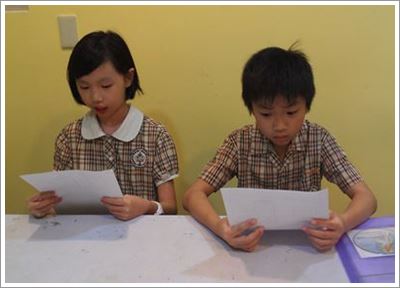|
In-School Shuochang Performance
 Every day during lunch, there will be sounds of broadcasting coming from the speakers, and the entire school gets ready for another episode of ‘Voice of Yu-Tsai.’ Starting 2014, ‘Fun with Talking, Imitating, Teasing, and Singing’ became a regular program on Voice of Yu-Tsai. The program introduces different types of shuochang through on-air performances and classic shuochang videos, and the students were able to experience four major elements of shuochang. Lunchtime at Yu-Tsai is no longer time to entice our taste buds; it is also time to enrich our souls with the art of shuochang.
‘Fun with Talking, Imitating, Teasing, and Singing’
Hosts:Jackie, Carol / Jackie, Casper
Outline:
Shows in the first semester began with an introduction on the art of shuochang. As the weeks went on, the program covered different types of shuochang in more depth. For example, the history behind each form of shuochang performance, and the way each one is performed.
Shows in the second semester were more general, and the topics were something that we could relate to more easily. The shows used cross talks duo to introduce different topics, and the hosts would conclude the show with a shuochang video clip from the Internet.
Program Format:
Two hosts will form a pair and imitate a cross-talks-styled dialogue to present a linguistic performance in a humorous fashion. |
Preparation work for the hosts
The program may be only 20 minutes in length, but it takes a lot of preparation work beforehand to make the art of shuochang presentable on air.
Before each show, the hosts have three learning missions to complete:
1. Data collection and integration: Search data according to the weekly topic, and then organize the data into sensible information
2. Writing and creating: After writing a detail shuochang introduction, the hosts would then start writing the script for the radio show. The script must be edited by Ms. Li before going on air.
3. Rehearsal: After the script is finalized, the two hosts would start practicing. It is after all the hard work that we are able to present one content-rich episode after another during lunchtime radio broadcasting at Yu-Tsai. |
Sample Script
Program Title: Fun with Talking, Imitating, Teasing, and Learning
Program Theme: The Art of Shuochang
Scriptwriters: Jackie, Carol
Broadcast Script:
 |
 Jackie and Carol: Today is a special day, a meaningful day, a fruitful day, a bright and shining day. Just exactly what kind of day is it? It is the premier of ‘Fun with Talking, Imitating, Teasing, and Learning.'
Jackie: When I was in third grade, the school started a fun class – the art of shuochang. Under the guidance of Ms. Li, we learned to talk the talk! We hope to share what we have learned with everyone on the air.
Carol: Jackie, can you explain to everyone, what is ‘the art of shuochang’ exactly? Is a tongue twister also a form of shuochang art?
Jackie: Precisely! If you are able to do tongue twisters and storytelling with clappers very well, then you, too, have learned to talk the talk. The art of shuochang includes literature, language, music, and performance. It is also known as ‘quyi,’ which is the combination of songs and arts. Quyi is derived from folk songs and literatures. With the development of time, quyi became a unique kind of art form. Put it more simply, quyi can be divided into four types:
 Carol: You are absolutely right. The four types are cross talks, pingshu, clapper talks, and gu qu. When it comes to cross talks, then it gets really interesting. The script can be about anything. You can talk about distant stars or isolated lands. You can make fun of the old and tease the new. You can play linguistic game. You can study dramas. It is an art form that includes ‘laughter’ as a main component. One person can perform cross talks monologue. Two people can perform cross talks duo. When you have more than three people, you can do group cross talks or cross talks duo.
Full Broadcast Script download-link
|
 |
Program Title: Fun with Talking, Imitating, Teasing, and Learning
Program Theme: The Origin of Children’s Day, Selecting Model Students
Scriptwriters: Jackie, Casper
Broadcast Script:
 |
|
Jackie: Hello, I’m Jackie
Casper: I’m Casper
Jackie and Casper: Welcome to another episode of ‘Fun with Talking, Imitating, Teasing, and Learning’
Jackie: Casper, don’t you think the passing of time has been so fast? It will be April soon!
Casper: Yes! That means we are going to have a long weekend soon!
Jackie: Long weekend? Oh yeah, Children’s Day and Tomb Sweeping Day together.
Casper: Jackie, did you know the origin of Children’s Day?
Jackie: Yes, I do. Before we were born, in 1993, Women’s Day, which was celebrated on March 8th, and Children’s Day, which was celebrated on April 4th, were combined into Children’s Day, celebrated on the fourth of April. which was celebrated on March 8th, and Children’s Day, which was celebrated on April 4th, were combined into Children’s Day, celebrated on the fourth of April.
Casper: Exactly! As a kid, I must know the origin of Children’s Day. In fact, as early as 1925, representatives from more than 54 nations held the World Conference for the Well-being of Children in Geneva, Switzerland.
Full Broadcast Script download-link
|
 |
|

Broadcast ScriptSource:Jackie,Casper | Text: the Original Artsy Shuochang Posse │ Pictures: Jackie's father provide
|






